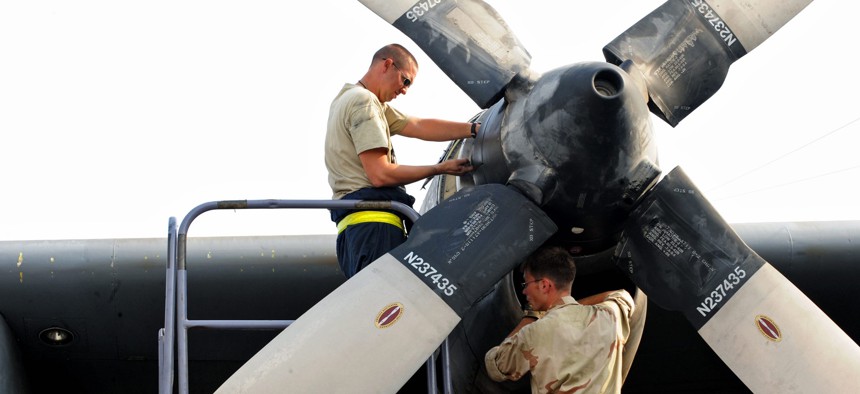
U.S. Air Force Tech. Sgt. Christopher Chadwell, left, performs a propeller hydraulic fluid level check while Staff Sgt. William Aker does an engine inlet inspection on a C-130E Hercules aircraft somewhere in southwest Asia on Aug.11, 2010. U.S. Air Force / Senior Airman Laura Turner
Trump’s Military Buildup Won’t Begin Until 2019
Pentagon officials say they're working to fix readiness first, then grow the military.
Don’t expect to see President Donald Trump’s promised military buildup kick into gear until 2019, senior Pentagon officials said Tuesday, hours after delivering their 2018 request to Capitol Hill.
The $639 billion defense spending request — that’s a $574 billion “base budget” plus $65 billion to fight in Iraq, Afghanistan, and Syria and send more troops to Europe — tops the current year’s base-plus-overseas contingency operations total by about $52 billion.
It’s “the next step in rebuilding the armed forces,” acting Pentagon Comptroller John Roth told reporters at the Pentagon. “That is a significant increased commitment on the part of this administration to defense spending.”
But it still falls short, according to Sen. John McCain, R-Ariz, who leads the Senate Armed Services Committee. Trump’s budget plan is “inadequate to the challenges we face, illegal under current law, and part of an overall budget proposal that is dead on arrival in Congress,” McCain said.
Trump’s proposal is $52 billion above federal spending caps mandated by the Budget Control Act of 2011. Legislative compromise on those caps seems unlikely in the context of the overall budget proposal, which aims to cut billions of dollars from domestic and safety-net spending and sets up a fight with congressional Democrats.
During the 2016 campaign, Trump pledged to buy more warships and combat aircraft. Just days after taking office, the new president signed an executive order at the Pentagon to underscore his desire to fulfill those campaign promises.
Now four months into his presidency, Pentagon officials say those increases will take time.
“You will not see a growth in force structure” in Trump’s 2018 budget projections, Roth said. “You will not see a growth in the shipbuilding plan. You will not see a robust modernization program.”
Instead, Roth and other Pentagon officials have pointed to Defense Secretary Jim Mattis’ three-step approach to rebuild the military. It aims first to fill equipment and training holes, then to increase the capacity of the military, and finally, to make it more lethal. Last week, Joint Chiefs Chairman Gen. Joseph Dunford told Defense One that he expects the Pentagon to start buying new weapons in the coming years to meet those goals.
The documents that accompany the Pentagon’s 2018 spending request most lack long-term projections. Roth said that’s because decisions about future budgets will be shaped by military strategy reviews now underway.
“The secretary has not spent any time at all looking at anything beyond FY18 to date, in large part because what we have stood up … is we begun the process of developing the new defense strategy,” Roth said Tuesday. “The intent and the goal was that that new defense strategy would inform anything beyond FY19.”
But the acting comptroller said to expect an uptick in Pentagon spending down the road. Roth said that the relatively flat, long-term defense spending projection released by the White House “is not the top line that we will be seeking here particularly as we go to the FY19 budget.”
“That flat line is not informed by strategy and it’s not informed by policy,” he said.
Will Congress would approve Trump’s Pentagon spending proposal?
“I’m actually fairly sanguine,” Roth said. “Actually, a lot of the reaction we’ve gotten so far from our meetings with some of the members is ‘Why didn’t you ask for more?’”
